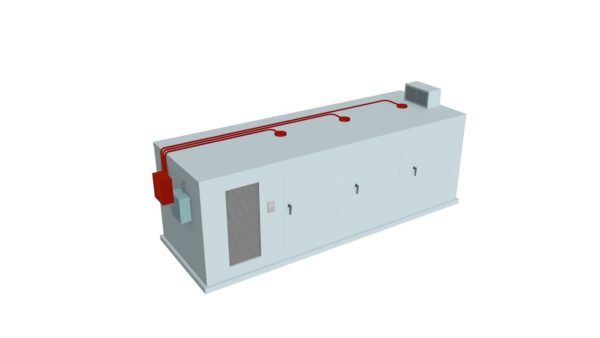Tenaska and Arevon plan to develop a 200 MW, $175 million solar array in Scott County, Missouri, in the southeastern part of the state.
The Kelso Solar Project is planned for roughly 2,000 acres along Interstate 55 near the town of Blodgett. Land for the solar field is being leased from local landowners. Pending necessary approvals, construction could start in 2022 or 2023. Once complete, the solar field will be operational for 35 years and employ around 10 people full-time.
Developers said the project’s scale could grow to 350 MW. The project is in early stages of development and no equipment suppliers have been named.
Arevon is a unit of Capital Dynamics, a private asset management firm. In late 2018, Capital’s Clean Energy Infrastructure business signed a deal with independent power producer Tenaska to develop 14 solar projects with around 2,000 MW of capacity in the Midcontinent Independent System Operator market. Projects were planned in Michigan, Missouri, Illinois, Wisconsin, Indiana, and Minnesota.
Hydrogen from nuclear power plants
Bloom Energy will work with the Energy Department’s Idaho National Laboratory to test using nuclear energy to create hydrogen using Bloom Energy’s solid oxide, high-temperature electrolyzer.
Hydrogen would be obtained through electrolysis powered by nuclear generation. The idea is that rather than ramping down power generation when the grid is filled with renewable energy, electricity generated by nuclear plants can be used to produce hydrogen.
Steam supplied to the electrolyzers can also be generated by the power plant’s thermal energy, bolstering the overall efficiency of hydrogen production. INL will test Bloom Energy’s electrolyzers at its Dynamic Energy Testing and Integration Laboratory. Researchers can simulate steam and load following conditions as if the technology were already integrated with a nuclear power station.
Sandia launches an energy storage analysis tool
Sandia National Laboratory, also a DOE lab, developed a tool called Quest that can be used by energy researchers to evaluate energy storage scenarios.
The open-source software enables users to do their own energy storage analysis. It has two main tools: a behind-the-meter analysis tool for businesses or civil infrastructure, and a market-analysis tool to help utilities assess how much revenue an energy storage system would generate.
With the behind-the-meter analysis tool, users can estimate how much money an energy storage system may save them when combined with solar panels or other power generators.The user first inputs her location and the rate structure she pays. The user can also input the kind of renewable power system she has or wants to install.
The market-analysis tool looks at the other side of the equation. It was designed to provide small utility companies with an idea of how much revenue an energy storage system would generate by providing services to enhance the grid stability and reliability. The tool has historical data for the seven energy markets in North America, including the Electric Reliability Council of Texas and the California Independent System Operator, each with different market conditions.
Safety device for battery energy storage cabinets
A device developed at DOE’s Pacific Northwest National Laboratory can prevent dangerous conditions from developing in outdoor battery energy storage cabinets.
IntelliVent is designed to be installed in cabinet-style battery enclosures. It responds to smoke, heat, or gas alarms in the battery enclosure and automatically opens cabinet doors to prevent buildup of flammable gases. The technology reduces the risk of explosions at battery installations, which can damage property or endanger lives.

Recent fires at battery storage facilities in Arizona and England highlighted the dangers these kinds of fires can present. The April 2019 incident in Arizona at an energy storage facility left four firefighters injured, two seriously. In September 2020, fire crews in Liverpool, England, were called to a 20 MW battery storage plant after an explosion had occurred and found a large grid battery system container on fire.
Bobby Ruiz, fire chief in Peoria, Arizona, whose firefighters were injured in the Arizona incident, said that “getting all doors open early before gas buildup will make the incident safer.” He said doing so will also increase situational awareness by enabling responders to see if the batteries are smoking or are on fire.
The Snohomish County Public Utility District’s new Arlington Microgrid and Clean Energy Center in Everett, Washington, will be the first to install the technology when it retrofits a 1.2 MW battery.
Intellivent designers developed the system to work with a variety of sensors. It is intended to reduce the risk of explosion, but due to limitations of the product standard, is not designed to NFPA-69 (Standard on Explosion Prevention Systems). IntelliVent is available for low-cost, nonexclusive licensing from PNNL.
This content is protected by copyright and may not be reused. If you want to cooperate with us and would like to reuse some of our content, please contact: editors@pv-magazine.com.









By submitting this form you agree to pv magazine using your data for the purposes of publishing your comment.
Your personal data will only be disclosed or otherwise transmitted to third parties for the purposes of spam filtering or if this is necessary for technical maintenance of the website. Any other transfer to third parties will not take place unless this is justified on the basis of applicable data protection regulations or if pv magazine is legally obliged to do so.
You may revoke this consent at any time with effect for the future, in which case your personal data will be deleted immediately. Otherwise, your data will be deleted if pv magazine has processed your request or the purpose of data storage is fulfilled.
Further information on data privacy can be found in our Data Protection Policy.